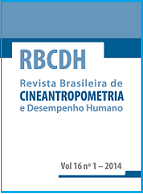Respostas da percepção subjetiva de esforço em teste incremental de mulheres idosas sedentárias
DOI:
https://doi.org/10.1590/1980-0037.2014v16n1p106Resumen
Apesar da percepção subjetiva de esforço (PSE) ser utilizada para a avaliação e prescrição de exercícios em idosos, alguns indivíduos podem apresentar dificuldades de entendimento a escala de Borg. Nesse sentido, o objetivo do estudo foi verificar se mulheres idosas percebem, associam e relatam alterações no esforço físico por meio da PSE, em resposta a um teste de esforço máximo, bem como se é possível predizer o ponto de compensação respiratória (PCR) pela escala de Borg. Vinte e seis mulheres idosas realizaram uma avaliação de esforço máximo em esteira com análise ergoespirométrica, eletrocardiográfica e PSE em protocolo de rampa. As respostas de PSE entre diferentes zonas de intensidade baixa, moderada e alta foram consideradas para avaliar a percepção, associação e relato de alterações no esforço. Oito voluntárias (30,77%) não perceberam, associaram e relataram alterações no esforço por meio da PSE. Naquelas que percebe-ram, associaram e relataram alterações no esforço, o percentual da potência máximano momento da PSE 13 (69,92 ± 10,30) e 14 (78,90 ± 11,00)não diferiu significativamente do momento do PCR (75,45 ± 9,65). Por fim, conclui-se que mulheres idosas podem apresentar dificuldades em perceber, associar e relatar alterações no esforço por meio da escala de Borg. Contudo, naquelas que percebem, associam e relatam alterações no esforço por meio da escala de Borg, as PSE 13 e 14 coincidem com o PCR.
Descargas
Publicado
Número
Sección
Licencia

Direitos Autorais para artigos publicados nesta revista são do autor, com direitos de primeira publicação para a revista. Em virtude da aparecerem nesta revista de acesso público, os artigos são de uso gratuito, com atribuições próprias, em aplicações educacionais e não-comerciais, desde que seja dada a atribuição. Esta obra foi licenciada com uma Licença Creative Commons Atribuição 4.0 Internacional - CC BY


